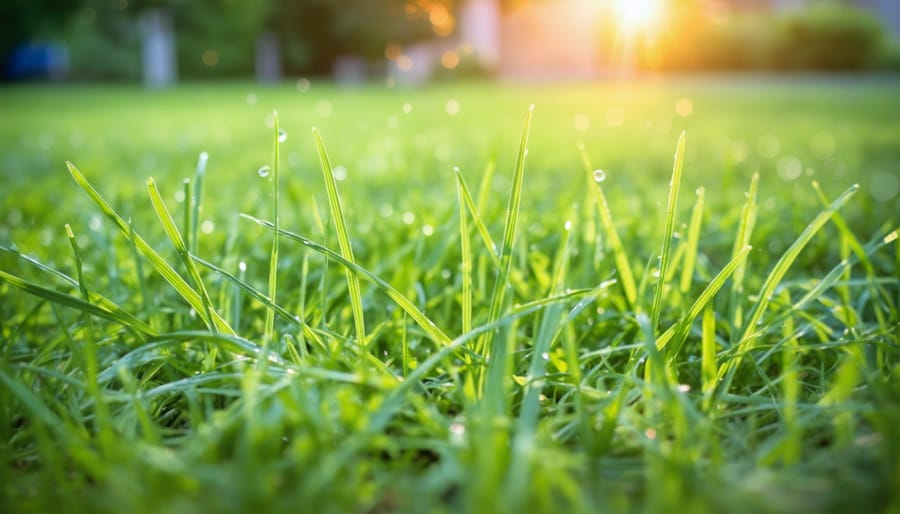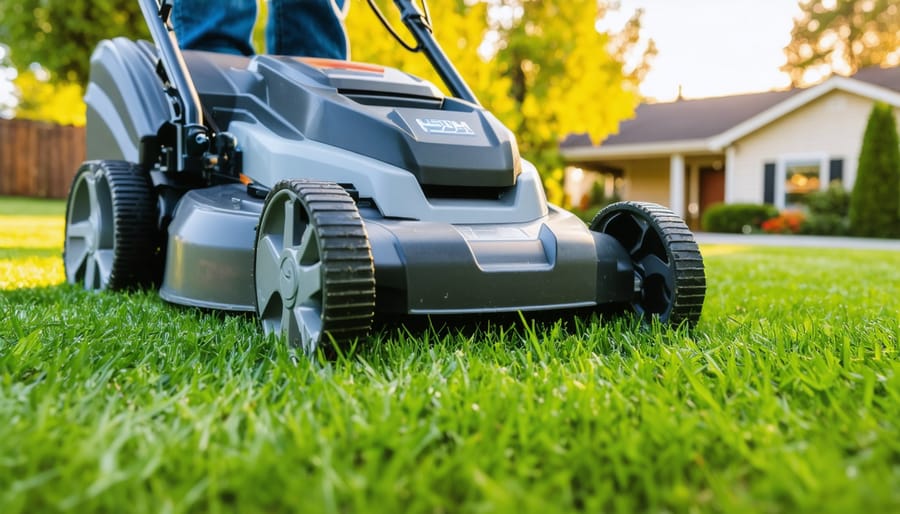Mowing your lawn to exactly 4 inches isn’t just a random number—it’s the sweet spot where grass roots grow deepest, weeds struggle to compete, and your turf naturally resists drought and disease. This taller height shades out crabgrass, reduces water needs by up to 30%, and creates that lush, carpet-like texture everyone admires. But reaching 4 inches is only half the battle. What you do in the hours and days immediately after mowing determines whether your lawn thrives or merely survives.
The right post-mowing care transforms a simple cutting into a regeneration opportunity. Your grass blades are healing from fresh wounds, photosynthesis is temporarily reduced, and the lawn is vulnerable to stress. Following a proven care routine protects this critical recovery period while maximizing the benefits of your optimal mowing height. Whether you’re new to lawn care or refining years of experience, these practical steps work with your grass’s natural biology rather than against it. Skip them, and you’ll waste the advantage that 4-inch cutting provides. Follow them consistently, and you’ll build a resilient, eco-friendly lawn that requires less water, fewer chemicals, and minimal intervention throughout the growing season.
The Science Behind the 4-Inch Sweet Spot
You’ve probably heard lawn care experts recommend keeping grass at 4 inches, but have you ever wondered why this specific height is so magical for most lawns? The answer lies in some fascinating plant biology that directly impacts your lawn’s health and resilience.
When you maintain your grass at 4 inches, you’re giving it the optimal conditions to develop a robust root system. There’s a direct relationship between blade height and root depth—taller grass blades support deeper roots. Grass kept at 4 inches typically develops roots that extend 4 to 6 inches into the soil, creating an anchor that helps your lawn access water and nutrients far below the surface. This is especially crucial during dry spells when surface moisture evaporates quickly.
Speaking of drought resistance, that 4-inch height is your lawn’s built-in insurance policy against hot, dry weather. The taller blades shade the soil beneath, reducing water evaporation by up to 50 percent compared to closely cropped lawns. This means you’ll water less frequently while maintaining a healthier, greener lawn—a win for both your water bill and the environment.
Here’s another benefit that’ll make you smile: weed suppression. When grass reaches 4 inches, it creates a dense canopy that blocks sunlight from reaching the soil surface. Without adequate light, weed seeds struggle to germinate. It’s nature’s own mulch layer, working around the clock to keep your lawn pristine without chemical interventions.
The photosynthesis advantage is equally impressive. Taller grass blades have more surface area to capture sunlight and convert it into energy, making your lawn naturally more vigorous and disease-resistant.
Most cool-season grasses like Kentucky bluegrass, perennial ryegrass, and tall fescue absolutely thrive at this height. Warm-season varieties such as bermudagrass and zoysiagrass can also succeed at 4 inches, though some prefer slightly shorter cuts. Regardless of which lawn mowing methods you choose, maintaining that 4-inch sweet spot creates a self-sustaining ecosystem that works with nature rather than against it.

What Happens to Your Lawn Immediately After Mowing to 4 Inches
The moment your mower finishes that last pass, your grass enters what I like to call a brief “recovery mode.” Think of it like this: every time you mow, you’re essentially giving your lawn a haircut, and just like us, grass needs a moment to bounce back from the trim.
Here’s what’s actually happening beneath those neatly cut blades. When you cut grass, you’re removing photosynthesizing tissue, which temporarily reduces the plant’s ability to produce energy. This creates a stress response where your lawn redirects its resources to healing those fresh cuts and regenerating lost leaf area. If you’ve ever noticed your grass looking slightly pale or dull right after mowing, that’s the stress showing.
This is exactly why the one-third rule matters so much. When you maintain your lawn at 4 inches and only remove about an inch or so with each mowing, you’re leaving plenty of green leaf tissue intact to keep photosynthesis humming along. Cut more than one-third of the blade height, and you risk sending your grass into shock, forcing it to tap into stored energy reserves in the roots just to survive.
The beauty of maintaining that 4-inch height is that it acts like a built-in safety net. Your grass has substantial leaf area working overtime to produce food, even after you’ve trimmed it. Those taller blades also shade the soil more effectively, keeping roots cooler and reducing moisture loss during that vulnerable post-mowing period. Within 24 to 48 hours, your lawn should be actively recovering, with growth resuming at the cut points. The less dramatic the haircut, the faster your grass returns to its happy, thriving state.
Essential Post-Mowing Care for Your 4-Inch Lawn
Leave the Clippings (Grasscycling at 4 Inches)
Here’s some good news: at 4 inches, your grass clippings become a powerful ally in maintaining a healthy, sustainable lawn. Leaving those clippings right where they fall, a practice called grasscycling, is one of the smartest moves you can make for your yard.
When you mow at 4 inches and follow the one-third rule, your clippings are short enough to decompose quickly, typically within a week. As they break down, they return valuable nutrients to your soil—enough nitrogen, phosphorus, and potassium to replace about 25% of your lawn’s annual fertilizer needs. Think of it as free fertilizer that you’re already making!
Beyond nutrition, those clippings act like a light mulch layer, helping your soil retain moisture during hot weather. This means you’ll water less and save money while supporting a more resilient lawn. The decomposing clippings also feed beneficial earthworms and microorganisms that improve soil structure over time.
There are a few exceptions when bagging makes sense. If your lawn has gone too long between mowings and you’re cutting off more than one-third of the blade height, the clippings might be too thick and could smother the grass beneath. Also, if you’re dealing with a disease outbreak or heavy weed seed production, removing clippings prevents spreading problems.
For most regular mowing sessions at 4 inches, though, just mow and go. Your lawn will thank you with deeper roots, richer color, and that healthy, sustainable growth we all want.

Watering After Mowing: Timing and Technique
The relationship between watering after mowing and maintaining a 4-inch lawn height is more straightforward than you might think. Here’s the good news: taller grass actually makes your watering routine easier and more sustainable.
Your 4-inch lawn develops deeper root systems compared to shorter grass, which means it’s naturally more drought-resistant and requires less frequent watering. After mowing, wait at least 24 hours before watering to allow your grass to recover from the cutting stress. This waiting period also lets the grass blades stand upright again, ensuring water reaches the soil effectively rather than sitting on flattened foliage.
When you do water, early morning is your best friend. Aim for that sweet spot between 6 and 10 a.m. when temperatures are cooler and wind is minimal. This timing reduces evaporation and gives grass blades time to dry before evening, preventing fungal diseases that love damp, overnight conditions.
The deeper roots of your 4-inch lawn mean you can water less frequently but more deeply. Apply about 1 to 1.5 inches of water per week, including rainfall. Use the tuna can test: place empty cans around your lawn and run sprinklers until they collect an inch of water. This tells you exactly how long to water each zone.
Avoid the common mistake of light, daily watering, which encourages shallow roots. Your taller grass deserves deep, infrequent watering that promotes the robust root system you’ve been cultivating. This approach conserves water while keeping your lawn healthier and more resilient.

Inspecting and Addressing Bare Spots or Damage
After you’ve finished mowing, take a few minutes to walk your lawn and play detective. This simple practice helps you catch potential problems before they become major headaches. Look for patches where the grass seems thinner or areas where the ground shows through. These bare spots can happen for various reasons—from your dog’s favorite lounging spot to heavy foot traffic or even fungal issues.
When you spot bare areas, don’t panic. Small patches (under six inches) often fill in naturally when you maintain that healthy 4-inch height, since taller grass promotes stronger root systems that spread laterally. For larger bare spots, gently rake the area to loosen compacted soil, scatter some grass seed that matches your existing lawn, and cover lightly with compost. Water consistently for the next two weeks.
Keep an eye out for brown patches that might indicate grub damage or disease. If the grass pulls up easily like loose carpet, you might have grubs. For disease issues, improving air circulation by avoiding evening watering usually helps. Remember, a lawn maintained at 4 inches naturally resists many problems through its robust root system and natural shade coverage. Think of these inspections as preventive medicine—catching issues early means less work and fewer resources needed long-term, which aligns perfectly with sustainable lawn care principles.
Blade Maintenance Between Mows
Sharp blades are your secret weapon for maintaining a healthy 4-inch lawn. When you cut grass with dull blades, you’re essentially tearing the grass rather than slicing it cleanly. This creates ragged, brown edges that make your lawn look unhealthy and invite disease. At 4 inches, these imperfections become even more noticeable, so blade sharpness really matters.
Here’s a simple test: After mowing, examine the tips of your grass blades up close. If they look frayed or whitish-brown, it’s time to sharpen lawn mower blades. Clean cuts should appear crisp and green.
For most homeowners mowing weekly, sharpening blades two to three times per season works well. If you’re mowing more frequently or tackling tough conditions, check monthly. Between sharpenings, keep blades clean by scraping off grass clippings after each mow. This prevents buildup that dulls the edge and promotes rust.
Pro tip: Keep a spare blade on hand so you can swap them out quickly. While one blade is being sharpened, the other stays in service. This sustainable approach extends blade life and ensures your 4-inch lawn always gets the clean cut it deserves.
Seasonal Adjustments for Your 4-Inch Lawn
Your 4-inch lawn isn’t a set-it-and-forget-it proposition. Throughout the year, your grass has different needs, and understanding these seasonal shifts will help you maintain that optimal height while keeping your lawn healthy and resilient.
In spring, you’ll notice vigorous growth as temperatures rise and rainfall increases. During this energetic period, you might find yourself mowing more frequently to maintain your 4-inch height. Don’t be tempted to scalp the lawn to reduce mowing sessions. Instead, stick to the one-third rule, removing only an inch or so at each mowing. This is also an excellent time to let those grass clippings return nutrients to the soil as your lawn actively builds its root system.
Summer brings its own challenges, particularly heat stress and potential drought. Here’s where your 4-inch height really shines. That extra blade length provides crucial shade to the soil, reducing water evaporation and keeping roots cooler. During hot, dry periods, raise your mower deck slightly higher, perhaps to 4.5 inches, to give your grass every advantage. Water deeply but less frequently, encouraging those roots to grow even deeper. If your lawn shows signs of stress by turning bluish-gray or footprints remain visible, it’s time to water.
As fall arrives, maintain your 4-inch height while preparing for winter. Continue mowing until growth slows significantly. The cooler temperatures encourage root development, so keep those clippings on the lawn to feed the soil ecosystem. In warmer climates where grass stays active year-round, you’ll maintain a more consistent routine, though you can ease up on watering as temperatures moderate.
For cold-climate gardeners, that final fall mowing should still target the 4-inch mark rather than cutting shorter, protecting crowns from winter damage while preventing snow mold issues that occur with excessively long grass.
Common Mistakes to Avoid After Mowing to 4 Inches
Even with the best mowing practices, it’s easy to slip into habits that undermine your hard work. Let’s talk about the most common pitfalls I’ve seen gardeners encounter after cutting their grass to that ideal 4-inch height.
First up is over-fertilizing. Many homeowners think taller grass needs more nutrients, but the opposite is often true. A 4-inch lawn already has deeper roots and better access to soil nutrients. Dumping on extra fertilizer can lead to excessive growth, forcing you to mow more frequently and stressing your grass. Stick to a moderate, slow-release fertilizer schedule that matches your grass type and season.
Another frequent mistake is watering immediately after mowing. While your lawn does need consistent moisture, watering right after cutting can encourage fungal diseases, especially if you’ve left clippings on the lawn. Wait at least a few hours, and ideally water early morning to give grass blades time to dry before nightfall.
Mowing too frequently defeats the purpose of maintaining that 4-inch height. Remember the one-third rule: only cut when your grass reaches about 5 to 6 inches. Resist the urge to mow just because it’s Saturday or because your neighbor is out with their mower. Your lawn operates on its own schedule.
Finally, don’t neglect your mower maintenance. Dull blades tear rather than cut grass, creating brown, ragged tips that invite disease. Clean your deck after each use and sharpen blades at least twice per season. Your sustainable lawn care routine depends on equipment that performs properly.
Maintaining your lawn at 4 inches isn’t just a recommendation—it’s a game-changer for creating a healthier, more resilient yard while supporting sustainable gardening practices. By keeping your grass at this optimal height and following through with proper post-mowing care, you’re investing in a lawn that naturally resists weeds, conserves water, and requires fewer chemical interventions. Your grass will develop deeper roots, stay greener during dry spells, and bounce back faster from stress.
The beauty of the 4-inch approach is its simplicity. You don’t need expensive equipment or complicated techniques—just consistent mowing practices, attention to blade sharpness, and a commitment to leaving those nutrient-rich clippings on the lawn. These small efforts compound over time, creating a self-sustaining cycle where your lawn becomes easier to maintain season after season.
Ready to take your lawn care to the next level? Explore our comprehensive lawn care guide for more expert tips and sustainable strategies. We’d love to hear about your experiences with the 4-inch method—what’s working for you, and what questions do you still have? Your lawn care journey matters, and we’re here to support you every step of the way.



